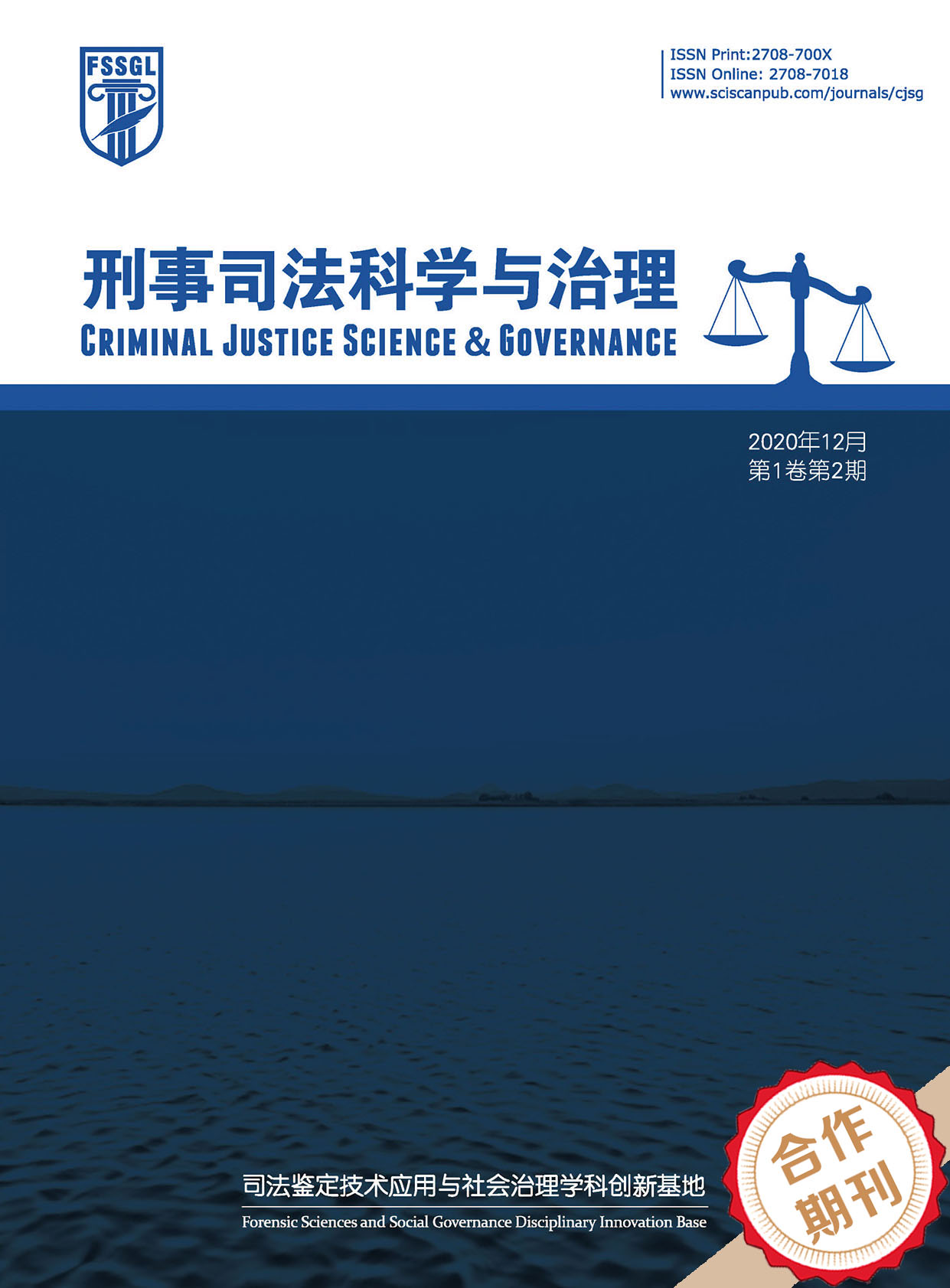Criminal Justice Science & Governance
电信网络诈骗案件侦查中电子数据取证困境及优化研究
Research on the Dilemma and Optimization of Electronic Data Forensics in the Investigation of Telecom Network Fraud Cases
- Authors: 林士钰
-
Information:
中南财经政法大学刑事司法学院,武汉
-
Keywords:
Electronic data forensics; Telecom network fraud; Investigation forensics; Data governance; Crossborder collaboration电子数据取证; 电信网络诈骗; 侦查取证; 数据治理; 跨境协作
- Abstract: Under the background of the digital transformation of the deep empowerment of digital intelligence technology, the crime of telecom network fraud presents the characteristics of ecological reconstruction, which is manifested in the monopoly of fraud groups, the maturity of the whole chain of the black ash industry chain, the compound of behavior patterns, the prominence of cross-platform and cross-domain characteristics, and the intelligentization of technical means, which seriously erodes the social trust mechanism and triggers systemic legal risks. Based on the dual perspectives of crime ecological evolution and governance technology iteration, this study systematically demonstrates the key effectiveness of electronic data forensics in case investigation and analyzes the triple practical constraints faced in its application through literature research, case deconstruction and comparative analysis, including the fragmentation of forensics regulation system, the technical adaptation dilemma caused by massive data and the obstruction of forensics cooperation mechanism. At the same time, in view of the above problems, combined with the global electronic forensics governance experience and the needs of China’s judicial practice, a targeted optimization path is proposed: First, establish a “clear, systematic, and detailed” electronic forensics system; Second, innovate the electronic forensics mode of “scientific sampling + technology empowerment”; Third, establish a three-dimensional collaboration network of “data interoperability and multiple collaboration”. 在数智技术深度赋能的数字化转型背景下,电信网络诈骗犯罪呈现生态化重构特征,具体表现为诈骗集团垄断化、黑灰产业链全链条成熟化、行为模式复合化、跨平台跨域特征显著化以及技术手段智能化等新态势,严重侵蚀社会信任机制并引发系统性法治风险。本研究基于犯罪生态演化与治理技术迭代的双重视角,通过文献研究、案例解构及比较分析等方法,系统论证电子数据取证在案件侦查中的关键效能,并剖析其应用中面临的三重现实掣肘:一是取证规制体系碎片化;二是海量数据引发的技术适配困境;三是取证协作机制梗阻。同时,针对上述问题,结合全球电子取证治理经验与我国司法实践需求,提出针对性优化路径:其一,建立“明确化、体系化、明细化”的电子取证制度;其二,创新“科学抽样+技术赋能”的电子取证模式;其三,建立“数据互通、多元协同”的立体化协作网络。
- DOI: https://doi.org/10.35534/cjsg.0601018
- Cite: 林士钰.电信网络诈骗案件侦查中电子数据取证困境及优化研究[J].刑事司法科学与治理,2025,6(1):164-173.
在数字化转型与数智技术深度融合的背景下,电信网络诈骗犯罪呈现生态化重构态势,其技术手段的迭代升级与犯罪模式的复杂演变对传统侦查体系形成严峻挑战。据2025年“两高”工作报告显示,2024年各级法院审结电信网络诈骗案件4万件,涉及8.2万人,同比增长26.7%;检察机关依法惩治电信网络诈骗犯罪,起诉犯罪嫌疑人7.8万人,同比上升53.9%。此类犯罪已形成诈骗集团垄断化、黑灰产业链全链条成熟化、行为模式复合化、跨平台跨域特征显著化以及技术手段智能化等新态势,严重侵蚀社会信任机制,更对法治秩序构成系统性冲击。
当前,电子数据取证作为破解此类犯罪的关键技术手段,其重要性已在学界与实务界达成共识。截至2025年3月18日,以“电子数据取证”为主题词在中国知网数据库中进行论文检索,显示有文献1141篇,但近年来相关研究的总体趋势有所下降(如图1所示);以“电信网络诈骗”为主题词在中国知网数据库中进行论文检索,显示有文献3463篇,总体仍呈现上升趋势(如图2所示);以“电子数据取证”和“网络诈骗”为主题词在中国知网数据库中进行论文检索,显示有文献24篇,且近两年研究总体趋势有所回升(如图3所示)。我国现有研究也产生了一些代表性观点,如学者刘敏提出应构建公私合作机制以畅通跨境电子取证路径、学者张庆轩、刘航主张构建合理的抽样取证规范体系,但整体仍有较大的研究空间。
本文结合现有研究,基于犯罪治理与技术赋能的交叉视角,综合运用文献研究、案例解构及比较分析等研究方法,系统论证电子数据取证在案件侦查中的关键效能,剖析其应用中面临的现实困境,并针对性探索以下三大方面的优化路径:其一,建立“明确化、体系化、明细化”的电子取证制度;其二,创新“科学抽样+技术赋能”的电子取证模式;其三,建立“数据互通、多元协同”的立体化协作网络。研究成果旨在为破解电子数据取证在电信网络诈骗案件侦查中的痛点提供解决路径,以期提升新型电信网络诈骗案件侦查的主动性。

图 1 “电子数据取证”总体趋势分析

图 2 “电信网络诈骗”总体趋势分析

图 3 “电子数据取证”并“网络诈骗”总体趋势分析
一、电信网络诈骗犯罪的新态势
电信网络诈骗是指以非法占有为目的,利用电信网络技术手段,通过远程、非接触等方式,诈骗公私财物的行为。自2022年《中华人民共和国反电信网络诈骗法》实施以来,反电信网络诈骗工作取得了一定的成效,一定程度上遏制了电信网络诈骗活动。公安部于2024年5月27日召开新闻发布会,通报了近五年来全国公安机关各项工作情况,其中提到:“五年来,共破获电信网络诈骗犯罪案件194.5万起,全国单月立案数同比连续8个月下降,受骗损失金额下降近30%,电信网络诈骗犯罪上升势头得到有效遏制。”
但随着科技发展日新月异,网络技术飞速发展,当下电信网络诈骗形势仍十分严峻,电信网络诈骗类型多样化趋势明显。除公安部公布的当下十大高发的电信网络诈骗类型——刷单返利、虚假网络投资理财、虚假购物服务、冒充电商物流客服、虚假贷款、虚假征信、冒充领导熟人、冒充公检法及政府机关、网络婚恋交友、网络游戏产品虚假交易这10种常见的电信网络诈骗外,电信网络诈骗还随着科技的迅猛发展,出现了“共享屏幕”“AI换脸拟声”、区块链和虚拟货币诈骗等新类型与新模式,诈骗手法紧跟时事热点,极具迷惑性与欺骗性。电信网络诈骗犯罪呈现出许多新特点,给公安工作带来了诸多挑战。
(一)诈骗集团垄断化
当前,零散、点状式的独立诈骗团伙逐渐减少,取而代之的是以“工业园区”“科技园区”等名义为掩护的超大犯罪集团。这些犯罪集团多设在境外,通过精心策划和组织,形成了庞大而稳定的诈骗犯罪网络,给社会带来了极大的危害。
例如,2024年12月1日公布的最高检、公安部联合挂牌督办的第四批特大跨境电信网络诈骗犯罪案中的“四川泸州‘3·21’系列电信网络诈骗案”,自2018年起,以陈某某为首的犯罪集团在柬埔寨“金财5”园区实施封闭式管理,通过武装安保和技术平台支撑,组织多个团伙以虚假投资理财、博彩等手法实施诈骗,使大量受害者蒙受巨额财产损失。这一案件深刻揭示了犯罪集团的运作模式和危害程度。
(二)黑灰产业链条成熟
《2024年互联网黑灰产趋势年度总结》一文中显示:“2024年,互联网黑灰产攻击依旧严峻”“2024年威胁猎人捕获全球新增作恶手机号1600多万例,日活跃作恶IP1170万例”,同时该文还反映了互联网黑灰产在电信网络诈骗这一攻击场景热度持续高涨。可见,电信网络诈骗黑灰产业链需引起持续关注。电信网络诈骗犯罪黑灰产业链,是指基于实现电信网络诈骗犯罪目的,围绕电话卡、银行卡、互联网账号等,形成的具有上下游关系的产业链。当前电信网络诈骗犯罪黑灰产业链日渐成熟,主要体现在以下三个维度。
一是技术支撑的隐蔽化。犯罪嫌疑人借助黑客技术,在电商支付、招聘平台简历下载等场景植入脚本程序,可瞬时抓取多类敏感信息,同时利用动态IP、Tor网络等躲避追踪与风控检测。相关研究表明,2024年黑产团伙不断升级技术,寻找更隐蔽的攻击资源,如通过在正常用户设备植入木马将其IP作为攻击资源。此外,“商户洗钱”产业链也在快速发展,威胁猎人在2024年针对“商户洗钱”产业链进行重点研究,发现目前已出现了“商户代收”(商家码)、“扫街码”“商户反扫”“商户代付”(核销码)等多种商户洗钱方式(如图4所示)。
二是产业链条的闭环专业化。电信网络诈骗犯罪形成了分工明确的上、中、下游产业链。上游以获取各类信息(如公民个人信息、网络账号信息、通讯信息、银行账户信息、网购信息、商业交易信息等)为目的,并将各类信息提供给诈骗团伙;中游提供通讯设备(如通讯线路、网络服务、桥接设备、应用程序等)及技术保障;下游以资金结算为目的,通过虚拟货币、地下钱庄等方式转移洗白赃款。例如“9·29特大跨境电信网络诈骗案”,其中各环节协作紧密,形成完整犯罪闭环。
三是黑灰产业工具的快速更新,攻击技术不断升级,更加智能化与便携化。例如恶意注册、暗扣话费、薅羊毛、刷单等,操作简单,犯罪门槛大大降低。研究表明,2024年黑产团伙对于通用技术的应用也有了新的发展,如滥用“子母机”绕过身份认证、利用“NFC远程传输软件”进行境外洗钱、定制化云手机系统提升攻击效率等。

资料来源:威胁猎人.2024年互联网黑灰产趋势年度总结[EB/OL].(2024-07-23)[2025-03-21].https://www.thepaper.cn/newsDetail_forward_28115796.html.
图 4 “商户洗钱”流程图
(三)行为模式复合性强
一是犯罪行为复合性强。随着诈骗集团的逐渐垄断化,其犯罪行为不再局限于单一的电信网络诈骗,而是呈现出多样化、交织化的态势。这些集团不仅继续从事传统的电信网络诈骗活动,更衍生出了人口贩卖、绑架、非法拘禁等严重侵犯公民人身权利的犯罪行为,影响极为恶劣。
二是电信网络诈骗模式复合性强。犯罪分子不再满足于刷单返利、虚假网络投资理财、虚假购物服务等单一的诈骗手段,而是开始尝试将不同的诈骗模式相结合,以形成更具欺骗性和迷惑性的复合型诈骗。例如“杀猪盘+虚假投资”和“赌诈结合型”等诈骗模式,极大地增加了诈骗的复杂性和隐蔽性。
(四)跨平台跨域性泛化
跨平台性主要体现在以下五个方面:一是电信网络诈骗手段的多平台融合,通过网站、视频平台、聊天软件等多个互联网平台对受害人进行多渠道联系;二是诈骗信息的跨平台传播,如利用社交媒体平台发布信息,通过搜索引擎优化曝光率,借助短信、电话精准发送诈骗信息;三是诈骗团伙的跨平台协作,“各司其职”;四是诈骗资金的跨平台转移,增加追踪与冻结难度;五是诈骗工具的跨平台应用,如Android木马等恶意软件的跨平台运用,在多个操作系统和设备上实施攻击。
跨域性突出体现在跨国境,主要分为人内网外(境内犯罪分子“翻墙”登录国外“暗网”实施诈骗犯罪)、人外网内(偷越到境外的犯罪分子通过遥控设在境内的GOIP无线网关设备,向被害人拨打诈骗电话、发送诈骗短信)、人网皆外(偷越到境外的犯罪分子利用境外即时聊天工具、网站实施诈骗)这三种模式。其中,境外电信网络诈骗犯罪团伙对境内居民实施犯罪最为突出。
(五)技术赋能犯罪专业化
随着黑产技术和产业的发展,电信网络诈骗与新型技术如区块链、虚拟货币、AI智能结合更加紧密,出现了诸多高技术型电信网络诈骗方式,大大降低了电信网络诈骗的技术门槛与成本。“广泛诈骗+精准诈骗”模式应运而生,犯罪分子由最初的“撒网式”诈骗向精准诈骗升级,运用人工智能等新技术对被害人精准画像,结合社会热点,除了对老年人、未成年人、“宝妈”等易受骗群体实施精准诈骗外,还通过利用被害人的关注点、情感痛点、人性弱点,逐渐突破年龄、职业、经历、地域等限制,实施“量体裁衣式”或“订单式”诈骗。同时,高科技自身的独特功能增加了侦破难度。
以利用“人机卡分离+远程操控+境外藏身”的GOIP群呼新型电信网络诈骗方式为例:其一,新型GOIP设备只需两部手机、一根音频线即可组网,实现远程控制拨打电话的功能,极大地降低了技术门槛;其二,GOIP设备具有的自动改号、语音播报和自由切换通讯线路等功能,使得群呼“广泛式诈骗”与人工“精准式诈骗”交替作业得以实现,极大地降低了犯罪成本;其三,GOIP设备可以利用远程控制系统的隔断功能,对侦查人员信息流溯源形成“物理隔断”,使得侦查人员难以获取诈骗窝点的真实IP。
二、电子数据取证在案件侦查中的效能
2021年最高人民检察院公布的《人民检察院办理网络犯罪案件规定》第二十七条明确电子数据为“以数字化形式存储、处理、传输的,能够证明案件事实的数据”。与2016年“两高一部”联合发布的《关于办理刑事案件收集提取和审查判断电子数据若干问题的规定》中的定义相比,这一表述去掉了“电子数据是案件发生过程中形成的”的限定,拓宽了电子数据的定义范围,使其更加适应网络犯罪的新形势和新特点。而电子数据取证则是依据法定程序,由具备专业资格的人员,依托计算机知识和技术对存储于电子设备中的电子数据进行的发现、固定、提取、分析、检验、记录和展示的综合性过程。
基于法国著名侦查学家艾德蒙·洛卡德提出的“物质交换原理”,犯罪分子在实施犯罪的过程中必然会在犯罪现场或者周围场所留下犯罪信息,这是不以人的意志为转移的客观规律。在电信网络诈骗领域,这一原理具体表现为电子痕迹的客观存在性与数据链的不可断裂性。电子数据取证作为契合该原理的具体实践举措,可对这些以数字形式存在的痕迹信息进行追踪与提取,在电信网络诈骗案件侦查中发挥着重要且独特的作用。
(一)以独特的取证内容精准查明犯罪线索
电子数据取证,作为现代刑事侦查的重要手段,其核心优势在于能够通过对存储介质的深入获取与细致分析,从中挖掘与案件紧密相关的线索和关键情报信息。这一过程不仅依赖于独特的取证内容,更离不开科学的取证流程。
科学的取证流程不仅决定获取数据的质量,也决定获取数据的有效性。电信网络诈骗犯罪中电子数据取证的基本程序及流程对于查明犯罪线索意义重大。根据我国电子取证规则和MDFM(Multi-Dimension Forensics Model)的架构,电子取证程序通常包含以下几个步骤:一是取证准备阶段,涉及取证人员的专业配置、取证工具的精心准备等;二是物理取证阶段,对硬件设备、存储媒介等进行细致搜集;三是数字取证阶段,运用专业技术手段提取电子数据;四是取证的全程监督,以确保取证活动的合法性与公正性;五是证据的呈堂,将经过严格审查的电子数据作为法律证据提交。
《公安机关办理刑事案件电子数据取证规则》第三条明确指出,电子数据取证的内容广泛,包括但不限于电子数据的收集与提取、检查与侦查实验、检验与鉴定等关键环节。实践中,电子数据取证工作的实施细化为五个核心方面:一是准备与受理,确保取证团队的专业性和工具的适用性;二是收集与获取,对硬件设备、存储媒介等进行收集,利用可靠方法获取数据,以产生电子数据的副本;三是计划与保护,制定科学、可行的取证策略与方法,确保数据完整性与安全性;四是检验与分析,含数据恢复与文件雕刻、数据解析与重组、证据关联与提取、数据解密与保护、代码分析与功能验证、差异对比、数据过滤和汇总等工作,运用数据恢复、关键字搜索、隐藏数据检测、注册表提取、密码破解等手段,深入剖析电子数据;五是验证与总结。
通过独特的取证内容和科学的取证流程,电子数据取证能够通过网络日志、邮件、聊天记录等渠道精准地追踪犯罪分子的数字足迹,从而查明犯罪线索,确定犯罪嫌疑人,为案件的侦破和审判提供有力支持。
(二)以高科技性提升侦查效率与准确性
电子数据取证的技术赋能使侦查模式从人力密集型向技术驱动型转型,显著降低了对传统侦查资源的依赖。以电子数据取证工作中的文件过滤与搜索等技术的应用为例,通过文件名、文件类型过滤,可以很大程度加快数据查找、分析速度,从而提高侦查效率,如案件关注的是图片,则只需查找jpg、png、gif、bmp等文件。同时,文件搜索功能能够在现有数据、已删除数据和松弛空间等位置中查找调查人员关注的内容。对于大量非结构化数据,还可以利用Lucene等索引引擎架构进行数据索引搜索,一定程度上提高了侦查效率与准确性。
在重庆市检察院第五分院办理的一起“零口供”贩毒案中,面对证据匮乏的状况,电子取证团队将希望寄托于嫌疑人随身携带的手机上,并在10天内提取梳理出了数十万条碎片化通讯记录,结合聊天记录、运输毒品轨迹、被抓获地点与时间、监控数据等信息,精准剥离出了犯罪嫌疑人的贩毒事实,最终完成案件的证据链构建,效率提升显著。
(三)提供法律证据支撑
一方面,电子数据本身具备明确的证据效力。现行《中华人民共和国刑事诉讼法》(2018年修订)第五十条沿用了2012年版《刑事诉讼法》第四十八条的规定,明确将“电子数据”列为与传统物证、书证、证人证言等证据具有同等效力的证据种类之一。这一规定不仅强调了电子数据在刑事诉讼中的重要地位,也体现了法律对于现代科技手段在刑事侦查中应用的认可与接纳。电子数据具备客观性、真实性与合法性,其法律效力受法律确认,在电信网络诈骗案件定罪量刑及法院判案中作用重大。
另一方面,电子数据取证工作中对被删除数据的恢复、关键证据的固定以及防止证据篡改的保护工作对案件侦破具有极高的价值。以“沈某”特大“网络水军”诈骗案为例,该案利用短视频流量推广进行诈骗,犯罪团伙通过非法刷量脚本程序生成虚假的数字身份和签名,误导短视频平台制造虚假流量。技术人员首先对现场存储着案件关键证据的数百部手机与电脑主机进行数据固定,包括非法刷量脚本程序、操作记录以及与犯罪活动直接相关的通讯数据,然后利用先进的取证技术,对电子设备实施全面的数据镜像固定,后续经过深入挖掘并分析刷量脚本软件的工作原理,成功揭露了犯罪团伙的诈骗手段,为警方提供了有力的证据链。又如乐陵市检察院办理的一起电信网络诈骗案,犯罪分子同时操控13部手机、一人分饰多角实施电信网络诈骗,审查起诉阶段全盘翻供,后检察机关自行补充侦查,通过电子数据审查工作恢复3亿多条有效数据成功指控犯罪。
三、电信网络诈骗犯罪中电子数据取证的现存困境
鉴于电信网络诈骗犯罪日益呈现出诈骗集团垄断化、黑灰产业链全链条成熟化、行为模式复合化、跨平台跨域特征显著化以及技术手段智能化等新型发展趋势,当前电信网络诈骗犯罪在应对与打击方面正面临着多重严峻挑战与困境,亟待司法工作者深入剖析并采取有效措施予以应对。
(一)取证规制体系碎片化
一是我国对于电子数据取证的立法尚未实现体系化,相关法律规定较零散且存在一定的滞后性。目前对于电子数据取证规定较为明确的法律文件主要集中于最高人民法院、最高人民检察院、公安部2016年颁布的《关于办理刑事案件收集提取和审查判断电子数据若干问题的规定》和公安部2019年颁布的《公安机关办理刑事案件电子数据取证规则》。尽管这两部法律文件为电子数据取证提供了一定的指导和规范,但它们在法律效力层级、条文内容的协调性和规范标准的统一性上仍有待加强。此外,技术革新与程序设定之间存在脱节,新型电子证据形态和取证手段可能无法得到现有法律的充分认可,其法定地位存疑。
二是电子数据取证的操作规范与标准缺乏统一性和明确性,重复性较多。例如,在电子数据完整性校验方面,我国法规与标准对采用何种哈希算法未给出明确规定,导致实际操作中标准不一,且我国多数侦查机关对哈希值校验方法的应用尚不熟练。检察部门反映,在公安机关提交的材料中,几乎很少能够见到在数据特征栏中记录哈希值的笔录材料。这影响了数据的可信度和证据的效力。
(二)海量数据引发的技术适配危机
在电信网络诈骗犯罪侦查领域,电子数据海量化已成为亟待解决的关键困境。这一现象是信息网络技术与诈骗手段交织发展的结果,给案件侦破带来巨大挑战。
一方面,电子数据的来源具有多样性。电信网络诈骗犯罪贯穿多个网络场景,包含在社交平台的前期诱骗沟通、电商平台虚构交易、第三方支付平台资金转移等环节,这些平台的数据存储方式、格式和管理机制各不相同,导致统一收集和整理电子数据的难度增加。另一方面,随着网络犯罪分工日益精细化,不同阶段的犯罪行为都会产生并积累新的数据,形成“数据雪球效应”,使整体数据量呈指数级上升。与此同时,电信网络诈骗犯罪中电子数据取证呈现高数据量与低价值密度并存的困境。不仅存在数据冗余、格式多样等问题,犯罪嫌疑人还利用加密技术、匿名网络等手段逃避追踪,产生大量看似无序实则隐藏关键信息的加密或隐藏数据,大大增加了数据处理、识别、筛选与解析的难度。例如,在盐城市大中地区人民检察院办理的“同城交友App诈骗案”中,犯罪嫌疑人王某等人通过虚构位置、培训话术等手段骗取300余万用户充值5亿余元。公安机关提取的电子数据高达700多GB,涵盖后台MySQL数据库备份文件、支付宝CSV文件和微信支付数据TXT文件等多源异构数据。常规的多表关联查询方式无法保证效率,亟需探索新路径与适配技术以辅助案件侦破。
(三)取证协作机制梗阻
在国内层面,电子数据取证面临纵向与横向协作的双重障碍。从纵向看,各级公安机关协作不畅。各级公安机关信息资源管理系统单独运行,缺乏有效的整合与共享机制,导致信息孤岛现象严重。从横向看,不同警种沟通协作不畅。一是各警种在线索挖掘、情报搜集等方面存在信息壁垒,受时空限制较大;二是各地区办案机关对网络犯罪管辖权的争议解决机制不够顺畅,容易发生互相推诿的情况,从而贻误侦破案件的最佳时机;三是第三方协助取证保障不足,我国对于第三方协助取证的规定存在空白与滞后性,在实践中,各单位的协助相对被动、消极,耗时长,侦查机关无法及时取得有效信息,错失取证时机。
放眼国际,电子数据的跨境取证协作不畅。主要有以下四个方面的问题:一是“倒U型”国际刑事司法协助审批程序冗杂,耗时长、效果不明显;二是单边取证合法性存疑,单边取证主要包括网络在线提取、远程勘验、技术侦查三种形式,其中因远程勘验、技术侦查带有较强的技术属性,对境外国家的司法主权侵犯程度较大;三是跨国网络服务提供商配合意愿低;四是跨境电信网络诈骗的法律适用、管辖权和取证标准复杂多变,犯罪边际效应大大增加了电子取证难度。犯罪分子充分利用法律漏洞和司法管辖差异逃避打击,如利用GOIP设备在东南亚的合法性,通过远程监控平台在东南亚合法操纵GOIP设备拨打网络电话。此外,过度依赖国际警务合作也可能导致追赃挽损工作效率低下,受限于不同国家间的司法差异和合作机制的不完善。学者周鑫提到:“若我国公安机关对国际警务合作产生过多的依赖,限于不同国家之间的司法差异,将会导致追赃挽损工作效率低下。
四、电子数据取证的优化路径探索
通过系统论证电信网络诈骗犯罪的新态势、电子数据取证在案件侦查中的关键效能,剖析电信网络诈骗犯罪中电子数据取证的现存困境,以下将结合国内外先进经验和司法实践需要,不断探索电子数据取证的优化路径,以便更好地预防、识别和打击电信网络诈骗犯罪。
(一)建立“明确化、体系化、明细化”电子取证制度
宏观上,首先要完善电子数据取证立法,构建明确化、体系化的法制框架。应强化电子数据取证的法律效力,构建具有高度权威性的电子取证法制基础,为电子取证工作提供明确的指导方向。在此基础上,应依据比例原则,合理界定电子取证过程中权力干预的正当界限,确保权力与权利的平衡。其次要进一步推动取证程序规则的体系化,统一电子数据取证的标准与规范,明确电子取证标准适度和行为适度规则,并加大对鉴真技术的重视与应用。
微观上,要推动电子数据取证程序规范的明细化,构建电子数据弹性证明标准以弥补法规的滞后性,推动取证文书规范化以减少取证工作疏漏,明确电子数据非法证据排除规则以规范取证过程,在兼顾保障人权与打击犯罪中不断推动取证技术适用法治化。
通过《刑事诉讼法》第四次修订将电子数据侦查取证措施纳入法治轨道,推进其法治化、体系化进程是其中一个可行路径。学者谢登科提出了修订的相关见解,如“将司法实践中出现的网络远程勘验、电子数据冻结等新兴侦查措施吸收到刑事诉讼法之中”“增设数据保存令、数据自动化比对等新兴侦查取证措施”“针对电子数据所承载基本权利的差异而设置不同类型侦查取证措施”等。
(二)创新“科学抽样+技术赋能”的电子取证模式
一方面,要构建起科学合理的抽样取证规范体系。《关于办理信息网络犯罪案件适用刑事诉讼程序若干问题的意见》第20条“按照一定比例或者数量选取证据”的抽样取证规则,是极其必要的。面对数量庞大的电子数据,应构建合理的抽样取证规范体系,以科学原理和方法指导样本选取,确保样本的随机性与典型性。同时以严密的监督和记录抽样过程与方法,确保取证的透明、可靠、合法。例如有学者提出,可利用分层抽样或系统抽样方法指导样本选取,还可以根据平台的用户数据结构,按照一定的时间间隔选取样本数据进行分。
另一方面,应不断更新技术手段,以适配海量数据,实现分析高效化。在数据处理、识别、筛选与解析方面,可综合运用数据挖掘、数据可视化等技术手段,提高分析效率与准确性。例如,运用数据挖掘技术识别、收集与分析数据,在识别和收集阶段,从不同的数据源中抽取出涉案数据,并存储到数据仓库中,同时建立备份库。然后进行数据预处理,包括数据清洗、数据变换和数据集成等,从而获得高质量的分析数据。运用数据可视化技术直观呈现数据,降低理解难度,提高分析效率。
挖掘并合理运用新的取证技术与取证工具,为侦查提供线索与方向。例如有研究指出,可以通过root权限提取数据,并成功用于案件取证。这种方法是将目标手机的数据克隆到已获取root权限的手机上,以绕过操作系统限制,访问受保护的数据,为案件调查提供电子线索并揭示行为模式。同时,该研究还开发了一款自动化软件工具,专门针对含大量时间戳记录的数据库表进行设计。该工具通过自动转换时间戳并提取关键数据,显著提高了数据处理速度,减轻了手动数据解析的负担,能够有效简化复杂应用数据的分析流程,尤其在处理大数据量时显示出高效率和准确性。
(三)建立“数据互通、多元协同”的立体化协作网络
在国内,首先应畅通侦查机关在电子数据取证中的纵向与横向协作机制,构建公安机关信息资源共享网络,推动各部门及时进行信息共享,加强网安部门与刑侦、技侦、情报部门的合作,强化多警种间的沟通协作;其次需明确电信网络诈骗犯罪管辖权机制,优化地区协同配合,有效解决网络虚拟空间层面管辖难的困境;最后要推动警企高效、高质量合作,完善第三方协助取证机制,进一步明确网络平台服务提供者、电子数据持有者等第三方配合取证的权利、义务、范围与期限,强化第三方协助取证的责任意识,推进第三方协助取证依法依规、及时有效,提升协助取证框架下的侦查效率。
在国际上,首先,应简化国际刑事司法协助审批程序,通过协商合作在跨境网络犯罪管辖议题上达成共识,从而构建便捷的跨境电子取证渠道,包括但不限于及时分享网络犯罪相关线索和信息,及时对刑事司法协助请求作出回应,积极探索证据标准共识并通过多边协议等方式设置一定标准。对于刑事司法协助方式,根据案件性质采取不同的审批程序与合作方式。我国可以考虑对不同案件分别采取“倒U型”的审批程序和“一字型”的合作程序,同时充分运用网络平台,探索请求书等文书材料的电子送达方式,降低时间成本,提高效率。
其次,严格限制单方取证适用情形,充分考虑他国司法主权与数字主权。可以借鉴一些国家的数据分类分级模式,对取证数据进行分类分级处理,对于不同性质或不同级别的数据,采取针对性的取证手段与标准。还可以建立适当的特殊情况机制,遇到采用单边取证技术可能出现与他国主权发生冲突的情形,可通过特殊情况机制,为采取该行为提供正当理由,不将该延伸取证手段视为侵犯他国主权的行为。例如,在发生目标数据不清晰、案件重大复杂等情形时,可以将其视为“善意情形”进行调查取证。此外,不断更新电子数据取证方式,对于单边取证方式,可以考虑建立起涉及电子数据取证程序、鉴真程序等的专门性立法,厘清现有法律规范之间的矛盾和冲突,同时确立完善的监督机制,将单边取证的合法性风险降到最低。
再次,与跨国网络服务提供商开展良性合作,加强与国际组织的信息交流,破除信息壁垒。同时,应改变对国际警务合作的观念,重视国际警务合作,但不能仅依赖于国际警务合作,应探索多层次、多方面的跨境协作路径。
最后,考虑重构刑事管辖标准,改变以地域为单一连接点的管辖确定方式,参考数据控制者模式以灵活确定网络空间中的管辖标准。以此来削弱犯罪分子利用司法管辖“钻空子”的侥幸心理。
五、结语
随着2022年《中华人民共和国反电信网络诈骗法》的出台,电信网络诈骗引起了全民的高度重视,电信网络诈骗犯罪治理取得了显著成效,全民反诈意识也得到了显著提升。但网络更新速度之快不容小觑,新型电信网络诈骗防不胜防,电子数据取证在打击电信网络诈骗犯罪的关键作用应当引起高度重视。如何破解现存电子数据取证难题、发挥电子数据取证的最大优势,意义重大。本文存在很多不足之处,但希望通过系统论证电信网络诈骗犯罪的新态势、电子数据取证在案件侦查中的关键效能,剖析电信网络诈骗犯罪中电子数据取证的现存困境并探索相应优化路径,可以抛砖引玉,引起我国学者对电子数据取证在电信网络诈骗案件侦查中运用的高度关注,切实提高我国侦破新型电信网络诈骗犯罪的能力,为维护网络空间安全作出应有贡献。
















